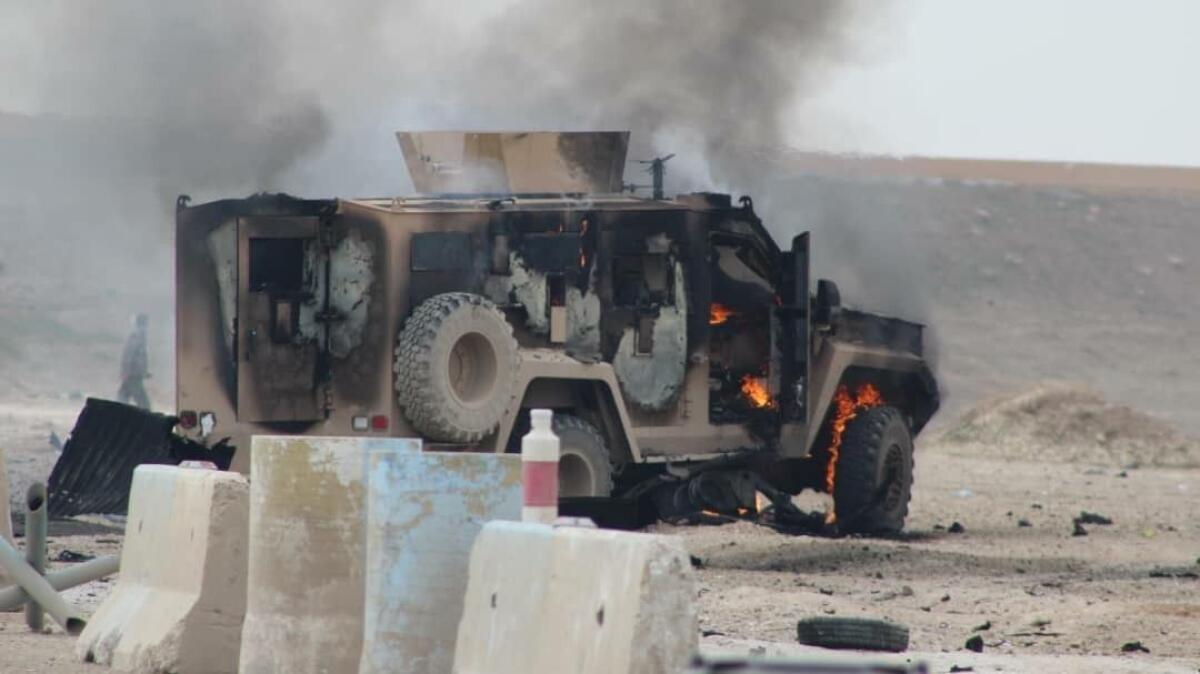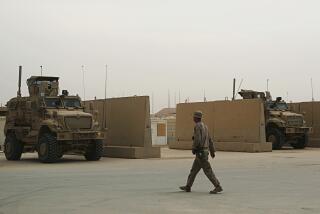Islamic State could exploit simmering ethno-sectarian tensions to forge a comeback, experts say, once U.S. withdraws from Syria

The fragile bond that has held together a coalition of ethnic and religious groups in the long-running and rugged fight against Islamic State would probably dissolve once the U.S. pulls its remaining troops from Syria ‚ÄĒ opening the door for the militant group to again rise as a dominant force in the region.
A quick drawdown of American troops in Syria, experts say, would inflame the existing tensions among Kurdish militias, the Turkish government and Sunni Muslims ‚ÄĒ an unlikely bloc that the U.S. has helped hold together only because of their shared interest in defeating the self-styled Islamist caliphate fighters.
Weeks after President Trump said he would withdraw American troops from Syria based on his assertion that Islamic State had been defeated, the militant group staged a suicide bombing attack Jan. 16 in the northern Syrian city of Manbij, killing two U.S. service members, a Defense Department contractor and a civilian Defense worker, as well as more than a dozen civilians and Kurdish militia members.
When the withdrawal is completed, the coalition’s resolve to finish off the job could be undermined if Turkey, the Kurds and the Sunnis turn on one another.
‚ÄúWhat the U.S. has tried to do with its presence in Syria was to manage this ethnic-sectarian tension,‚ÄĚ said Stephen Biddle, who served as a strategic advisor to U.S. Army Gens. Stanley McChrystal in Afghanistan and Gen. David Petraeus in Iraq. ‚ÄúAnd to try to diminish the underlying conditions that gave rise for support of ISIS,‚ÄĚ he said, using an acronym for Islamic State.
The ethno-sectarian rifts that have been simmering under the surface in northern Syria are part of a complex chess game involving groups with competing agendas and historical resentments.
Getting them to avoid bloody entanglements ‚ÄĒ let alone fight against Islamic State ‚ÄĒ has been a tall order even with the presence of U.S. troops.
Most of the multi-ethnic militias fighting Islamic State fall under the umbrella of the Syrian Democratic Forces, or SDF, which the U.S helped form in 2015. The coalition is dominated by Kurdish militias known as the People’s Protection Units, or YPG, but it also includes other fighting groups of Arabs and Assyrians.
With the U.S. gone, tensions could flare, allowing remaining Islamic State fighters and sympathizers to step into the breach.
The U.S.-backed Kurdish militias have long harbored aspirations for an independent nation. There are significant Kurdish populations in Iraq, Turkey, Iran and Syria. In northern Iraq, Kurds have been able to govern semiautonomously. Kurdish militias in Syria view defeating Islamic State as one step toward further achieving full autonomy, but this makes neighboring Turkey nervous. The Turkish government views Kurdish militias as part of an ongoing separatist movement that it has long sought to vanquish in southeastern Turkey.
The withdrawal of U.S. troops would leave Kurdish militias vulnerable to the Turkish government, which has already threatened to attack the Kurdish militias once the U.S. leaves Syria.
Without the U.S. watching over Kurdish militias, Sunnis would be left with no protection against the other groups.
‚ÄúPolitically, we are keeping Kurds and Sunnis from getting upset with each other and keeping Turkey on their side of the border,‚ÄĚ Biddle said. ‚ÄúBoth those functions help stabilize the politics in the region.‚ÄĚ
This leaves Kurdish militias open to attack ‚ÄĒ unless they turn to Syria‚Äôs Alawite government for protection.
The Sunni population in northeastern Syria have been spared the presence of the country’s tyrannical government for years because the Syrian government has had difficulty projecting its power that far afield.
But a shift in alliances would change that, stoking fears of the Sunni population which, like the Turkish government, feels threatened by the Kurds’ quest for autonomy and also by the oppressive Syrian government.
Sunnis would be left with only one group to turn to for protection: Islamic State.
‚ÄúISIS prospers when the Sunni community feels depressed and believes it needs ISIS to survive,‚ÄĚ Biddle said. ‚ÄúIt would create an opportunity for Islamic State militants because they can present [the group] as saviors of Sunnis.‚ÄĚ
Although Islamic State no longer controls major cities in Iraq or Syria, the United Nations estimates that the militant group still has up to 30,000 fighters in Iraq and Syria, many of them living among the local population, holed up in tunnels or camped out in the desert areas near the Iraq-Syria border, surviving by exploiting the lack of functioning governments in territory disputed by Arabs and Kurds in northeastern Syria.
Using improvised explosive devices and booby-trapping houses, the group has continued to cause considerable damage to the Syrian Democratic Forces, Col. Sean Ryan, a spokesman for the U.S.-led coalition fighting Islamic State, said recently.
Last month, Islamic State militants launched an attack against the coalition near the Sahjan oil field in Dair Alzour in eastern Syria, resulting in heavy fighting.
And despite Trump’s assertions, U.S.-led coalition forces conducted 469 airstrikes against Islamic State targets in northeastern Syria between Dec. 16 and 29, according to data released by the American military.
The level of tension between coalition members will depend on future events, such as the possibility of rapprochement between the Kurds and the Syrian government and the timing of the U.S. removal of its 2,000 troops.
But the planned scenario mirrors the underlying conditions that caused Islamic State to prosper after President Obama withdrew U.S. forces from Iraq in 2011.
There, the militant group known as Al Qaeda in Iraq took advantage of the Shiite Muslim-led Iraqi government’s sectarian nature to recruit marginalized Sunni Muslims. Some of those fighters split off and rebranded their forces in 2013 as Islamic State.
Sen. Lindsey Graham (R-S.C.) drew attention to this after the Islamic State attack in Manbij, saying Trump‚Äôs decision to withdraw from Syria has emboldened Islamic State. ‚ÄúI saw this in Iraq. And I‚Äôm now seeing it in Syria,‚ÄĚ Graham said at the confirmation hearing for attorney general nominee William Barr.
The attack in Manbij underscores how the U.S-led coalition has been tasked with defeating an evolving and complex threat and how removing U.S. troops is premature, said Daniel Byman, a senior fellow in the Center for Middle East Policy at the Brookings Institution.
‚ÄúThe caliphate is largely destroyed but a powerful underground insurgency still exists,‚ÄĚ Byman said. ‚ÄúISIS has an extensive network and has the ability to intimidate the population.‚ÄĚ
Follow me on Twitter @melissaetehad
More to Read
Sign up for Essential California
The most important California stories and recommendations in your inbox every morning.
You may occasionally receive promotional content from the Los Angeles Times.











